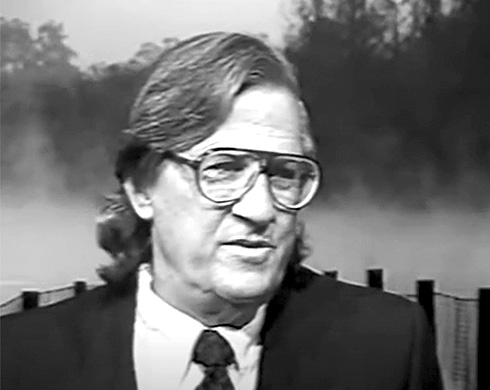Flip Schulke was an American photographer, born Graeme Phillips Schulke. He grew up in New Ulm, Minnesota. Schulke's nickname
"Flip" came about from his interest in gymnastics. He graduated from Macalester College, then moved to Miami. He taught briefly at the University of Miami, then began working as a freelance photographer. He worked for Life , and covered a variety of events, including the Cuban revolution. In 1962, he visited and photographed the Berlin Wall.
Schulke began photographing the civil rights movement in the American south as early as 1956. He formed a bond with civil rights activist
Martin Luther King, Jr. after an all-night conversation in 1958, and began photographing him. King invited Schulke to photograph secret planning meetings of the Southern Christian Leadership Conference, though not all of the activists trusted him being there. He also photographed the 1963 March on Washington and the 1965 Selma to Montgomery March. They traveled together until King's death in 1968, which upset Schulke so much that he stopped covering the civil rights movement and began to work on more commercial projects. In all, he took around 11,000 photographs of King, including some of his funeral.
Schulke photographed
Muhammad Ali,
Jacques Cousteau,
Fidel Castro and
John F. Kennedy. He also was a photographer for the Environmental Protection Agency's Documerica program in the early 1970s. Schulke died on May 15, 2008 at age 77.
The Dolph Briscoe Center for American History at the University of Texas at Austin holds 300,000 of his photographs. His photographs are also held in a variety of museums, including the Harvard Art Museums, the Cleveland Museum of Art, the National Museum of American History, the University of Michigan Museum of Art, the Minneapolis Institute of Art, and the Lehigh University Art Galleries.
Source: Wikipedia
My biggest problem with young photographers is that they don't think about context. They think about drama. You've got to know where to point your camera. -- Flip Schulke
When the Berlin Wall came down, thousands of people from around the world converged to celebrate the end of over 40 years of a divided Europe. Among them was American photojournalist Flip Schulke, who had visited the wall many times since it was erected in 1961 in an attempt to document what he described as
"man's physical ability to build a bastion between himself and his own dignity, if he tries hard enough". As he mingled with the crowd, he heard on their lips not a German protest song, but the famous American civil rights anthem
"We shall overcome". It was a song he knew well.
As a photojournalist in the 1950s and 1960s, Schulke captured many significant moments in the nation's struggle for civil rights in the 1960s, such as the marches to end segregation from Selma to Montgomery, Alabama, and Martin Luther King's funeral in 1968.
After the Berlin Wall went up in 1961, Schulke brought his civil rights experiences with him as he attempted to capture the wall's symbolic and physical power.
"This is the wall that fear built," Schulke wrote in notes during his visit to the wall in 1962.
"This was the wall where hate stood guard, and men stooped much lower than angels. On one side it was bright and clean from the sun of freedom. (On) the other dark and bitter - the rot of slavery."
Comprised of bricks, mortar, steel wire and jagged glass fragments to deter climbers, the wall both appalled and shocked Schulke, who described it as having a
"jerry built" look.
"It just can't be real," he noted, adding that the wall was a
"monument to human misery" that
"splits the world in half like a melon".
He recalled how on the western side German children played tag in the shadows of tank traps while on the other side children stood
"dull-eyed and pinch-faced in darkened doorways - wondering how one learns to laugh". As East German guards looked at him through their binoculars, Schulke observed recent East German escapees in West Berlin standing near the wall and signaling to friends and relatives back in East Berlin or waiting for relatives to appear.
"One woman waited five hours to see her mother who never turned up," Schulke wrote. "Another couple stood by the River Spree, the girl crying softly, trying to catch a glimpse of her mother across the river."
During Schulke's early coverage of the civil rights movement, he had a relatively balanced journalistic outlook and tried to see both sides, says
Gary Truman, a long-time friend and former colleague.
"But that faded quickly because he said that sometimes there is no other reasonable opposite view, there was only right and wrong," Truman says.
"I think his coverage of the Berlin Wall stated immediately: this simply is wrong."
Schulke saw both the wall and the civil rights movement as part of
"a greater conflict over universal human freedoms," says Truman, who became the archivist of Schulke's photo collection after the photographer's death in 2008.
"Similarities always exist in the artist's eyes."
Schulke was far from alone in seeing the parallels between division in America and in Berlin. Even before the famous
"Ich bin ein Berliner" speech by
President John F Kennedy, his brother
Robert Kennedy came to Berlin as US Attorney General in February 1962.
"For a hundred years, despite out protestations of equality, we had, as you know, a wall of our own - a wall of segregation erected against Negroes," Kennedy said.
"That wall is coming down."Source: BBC
